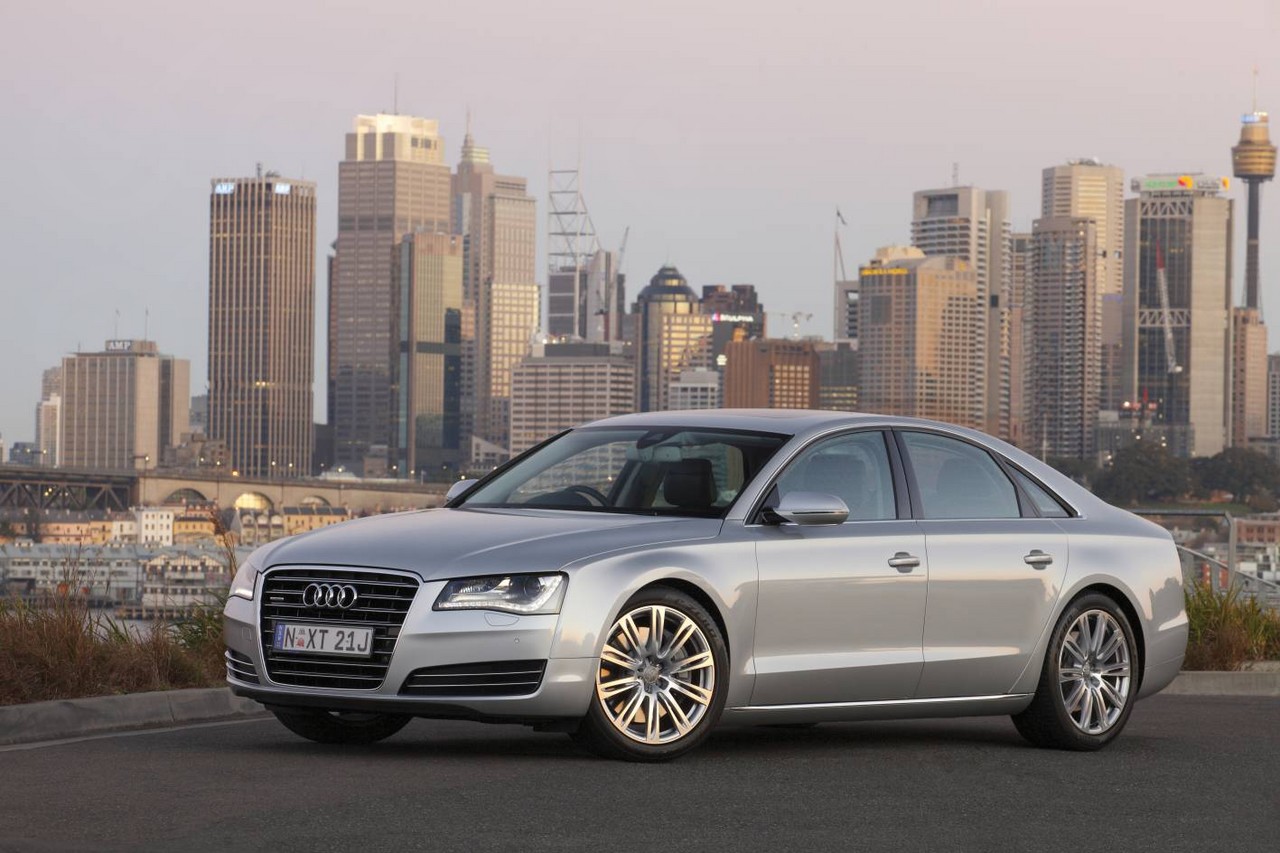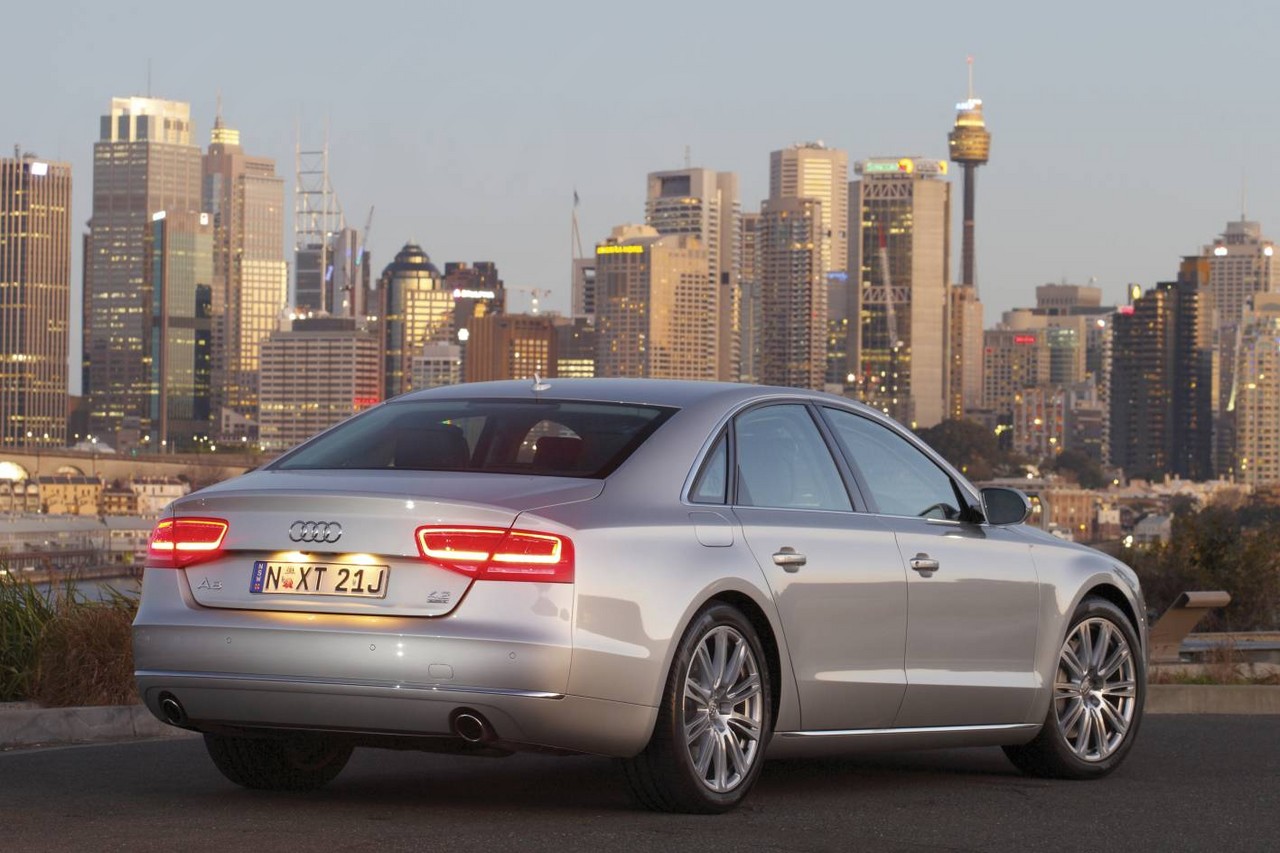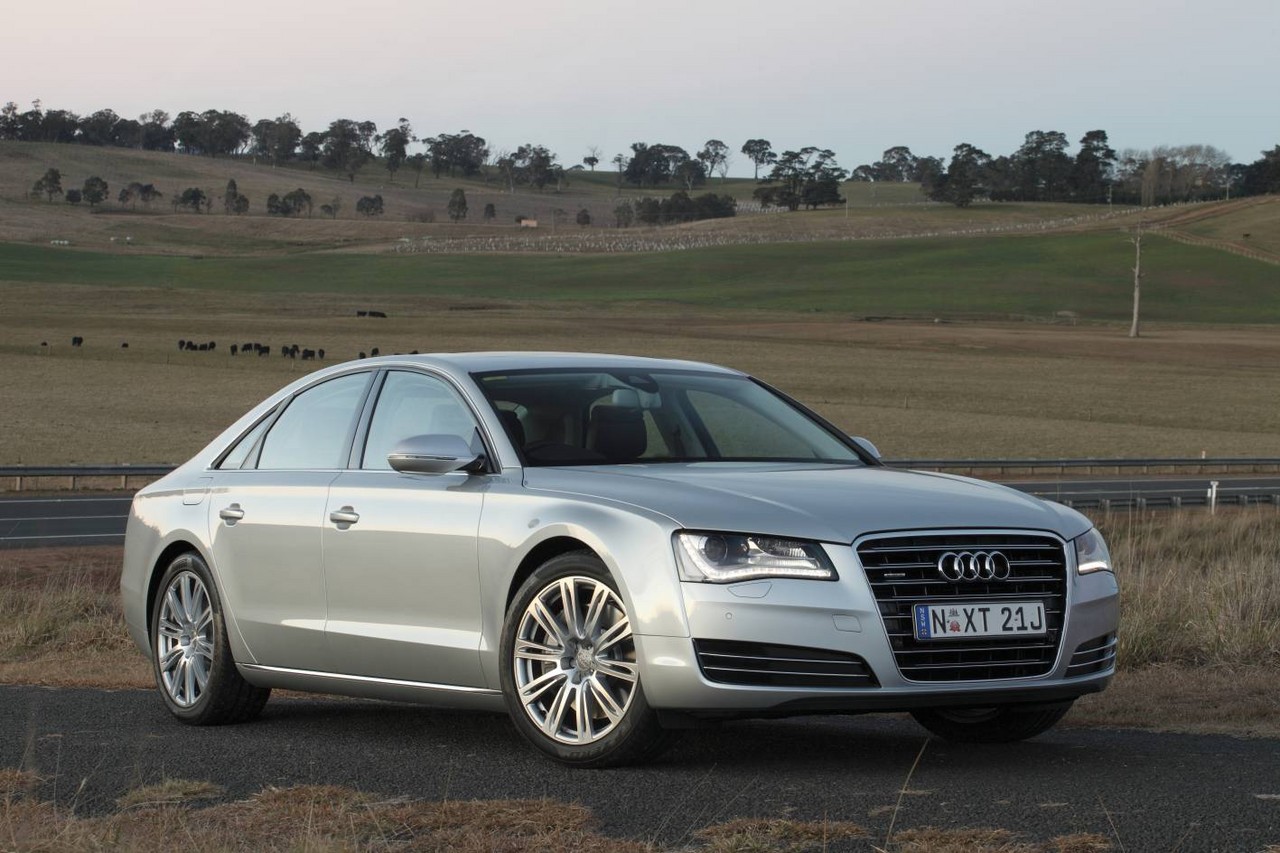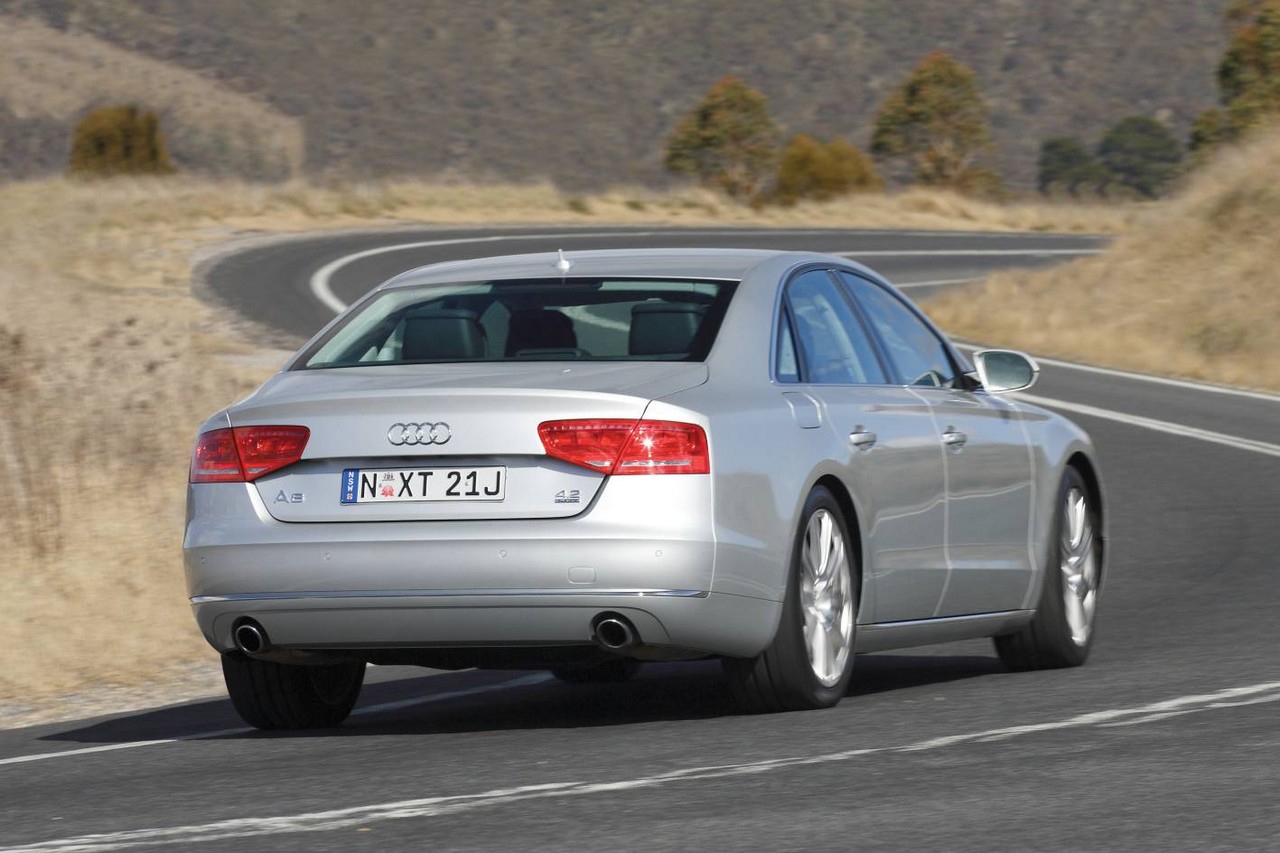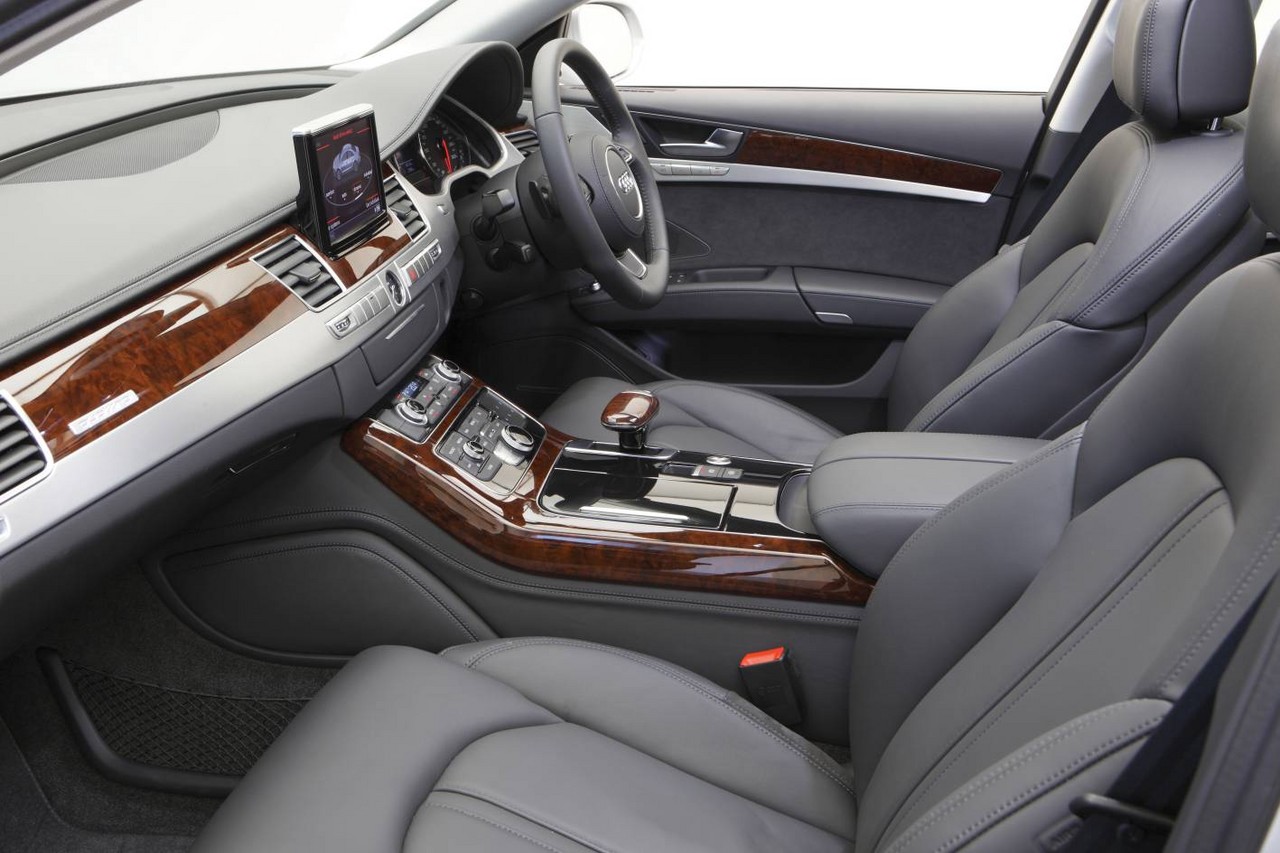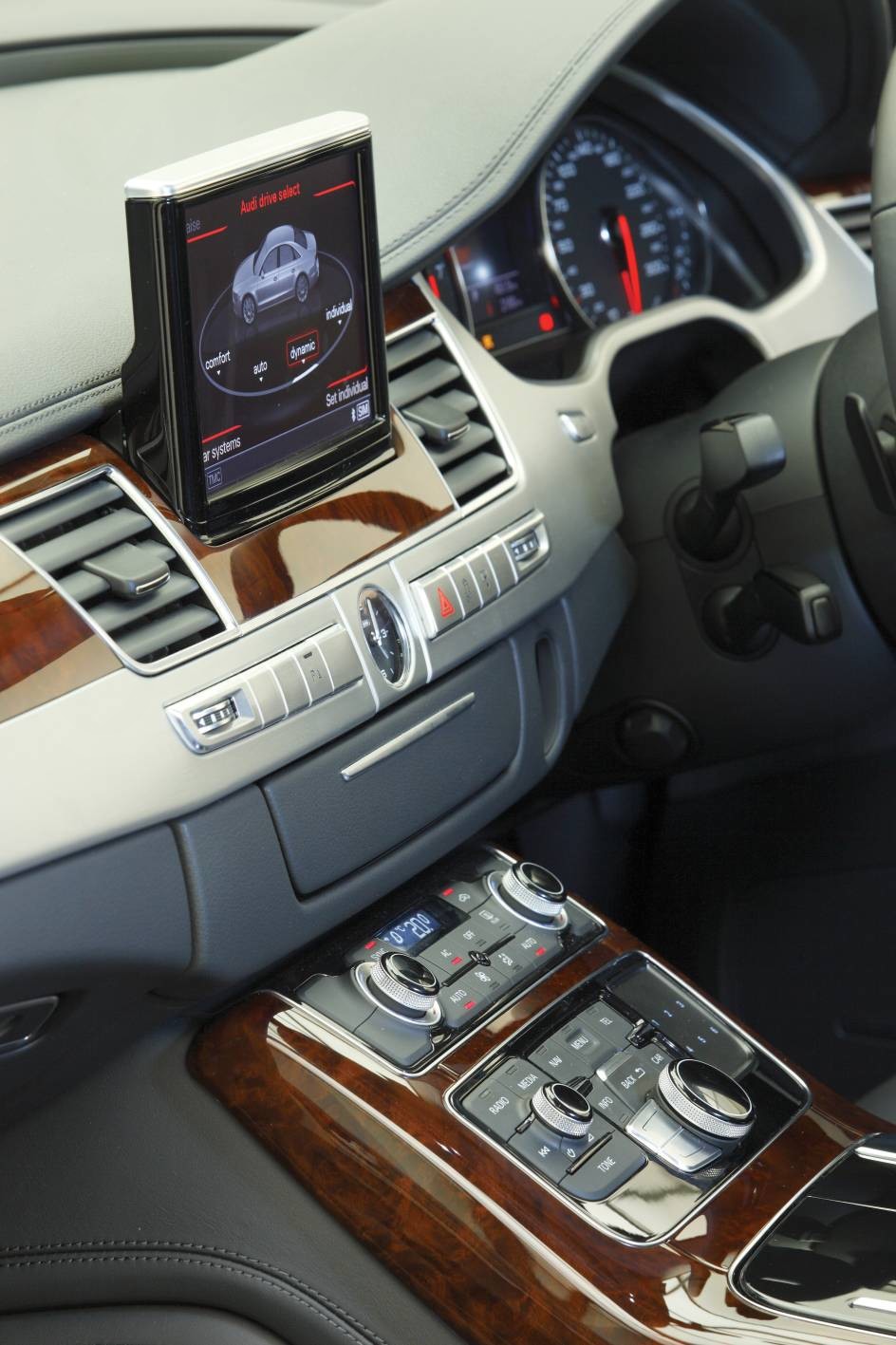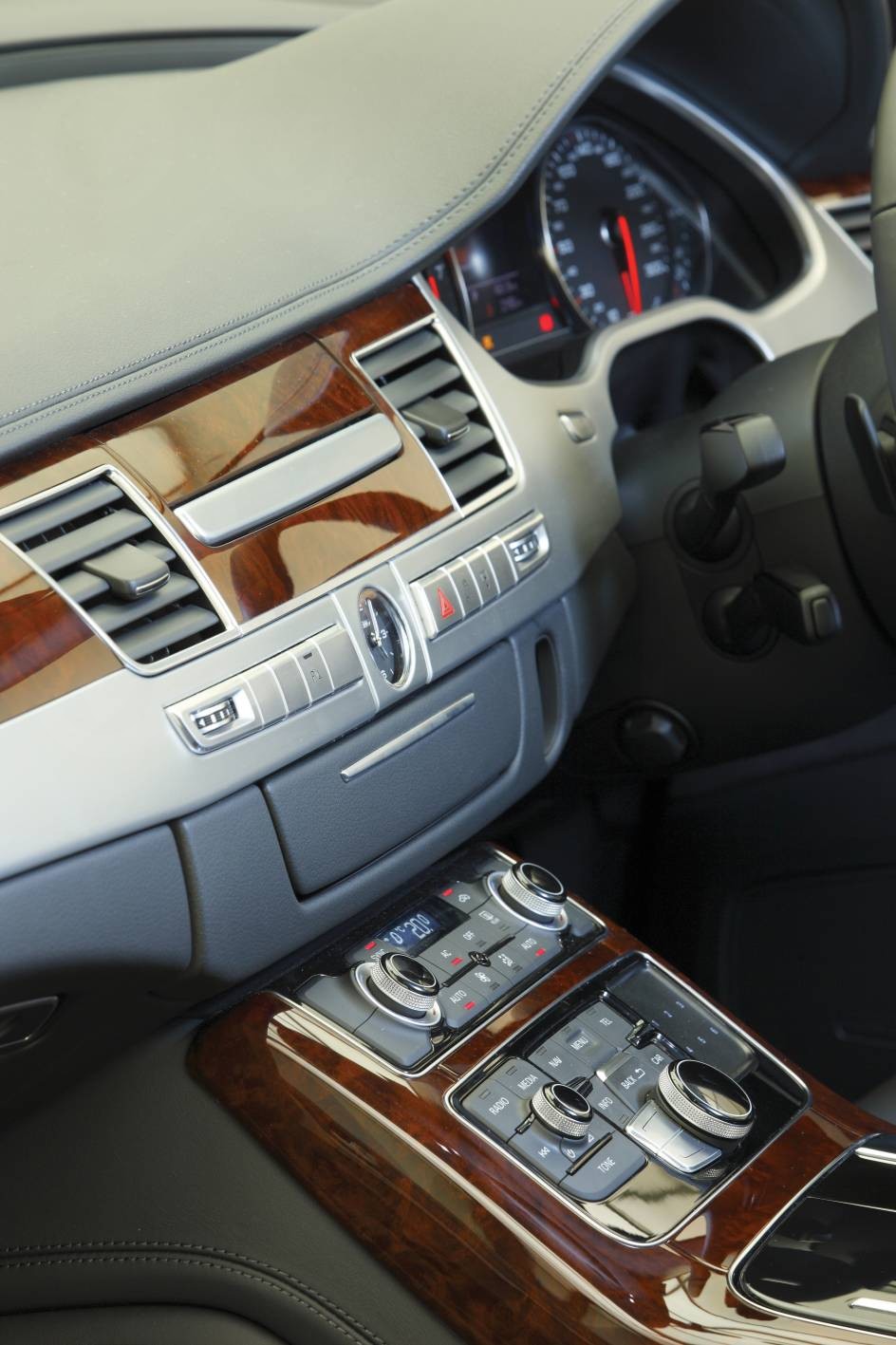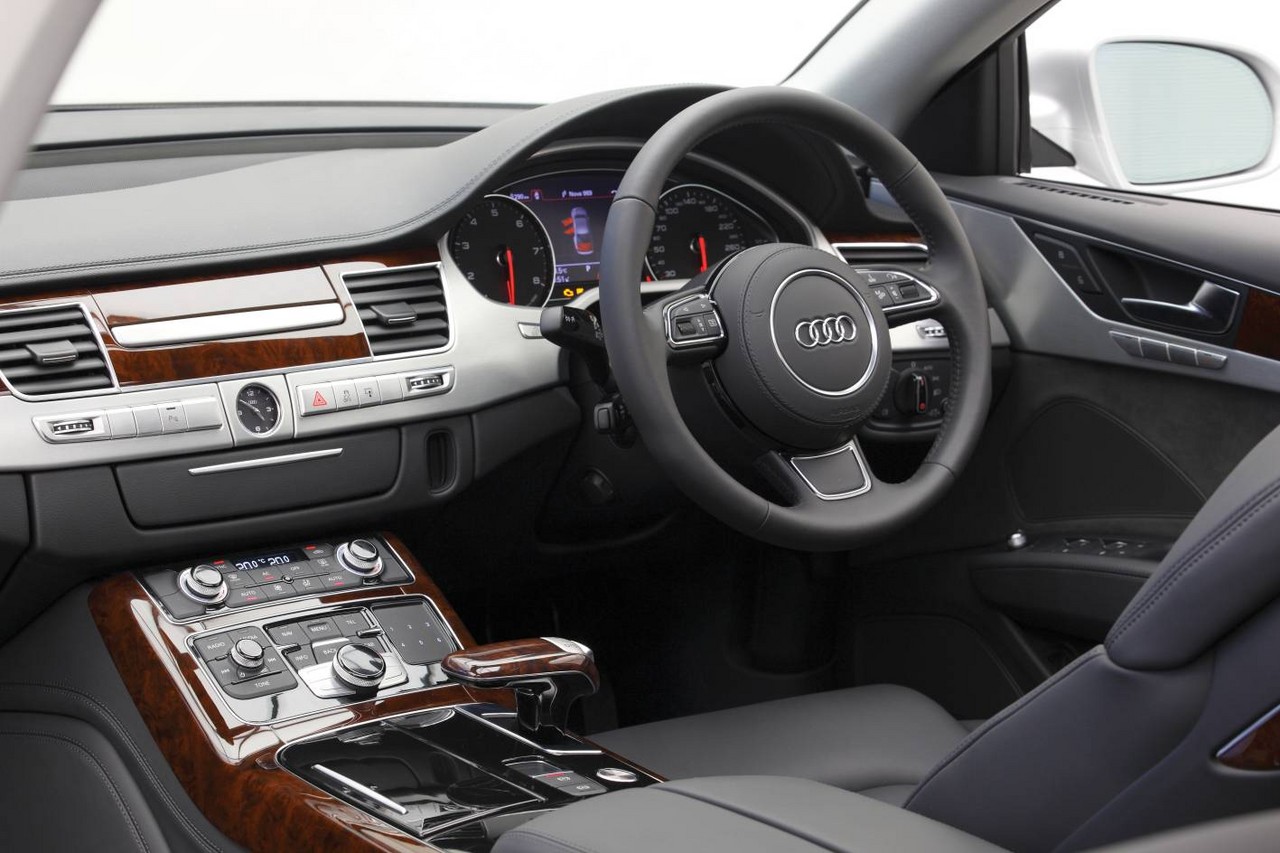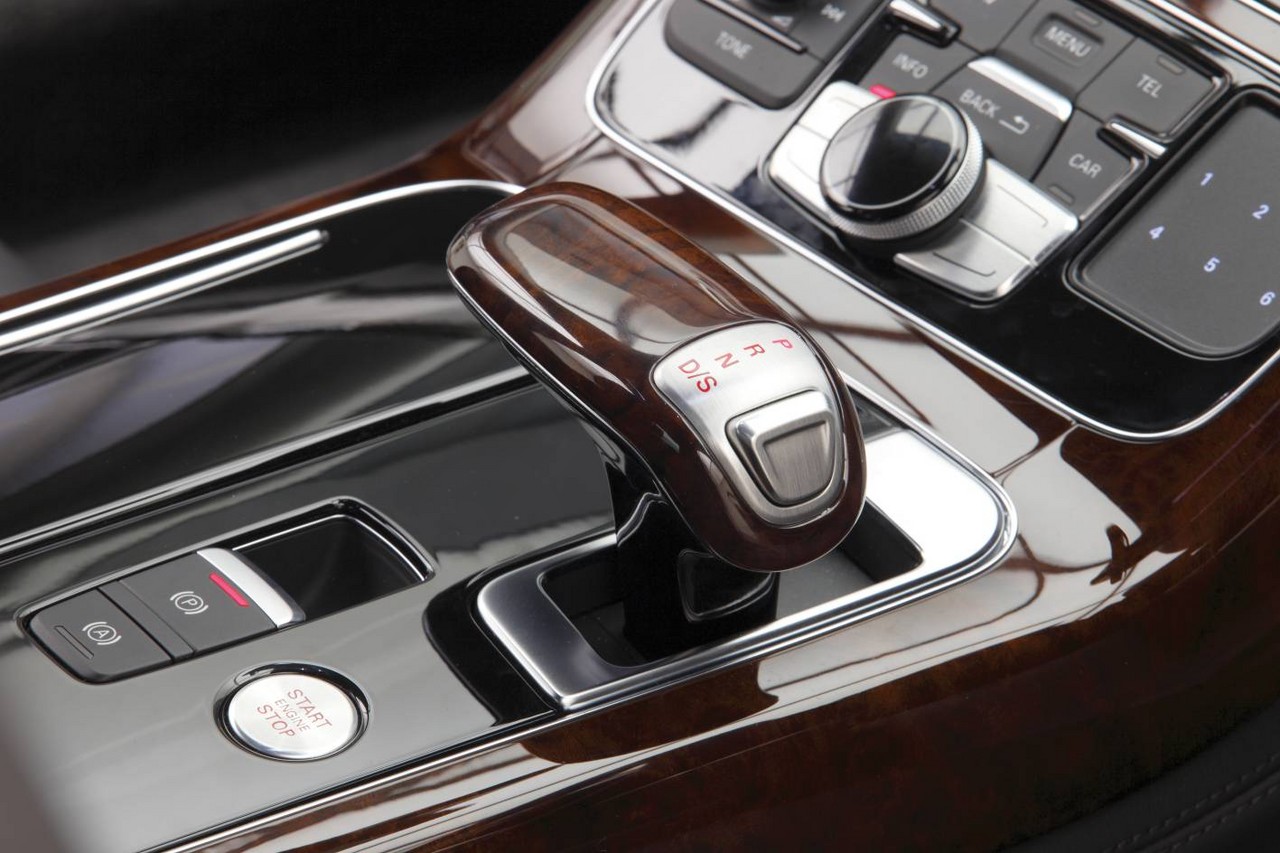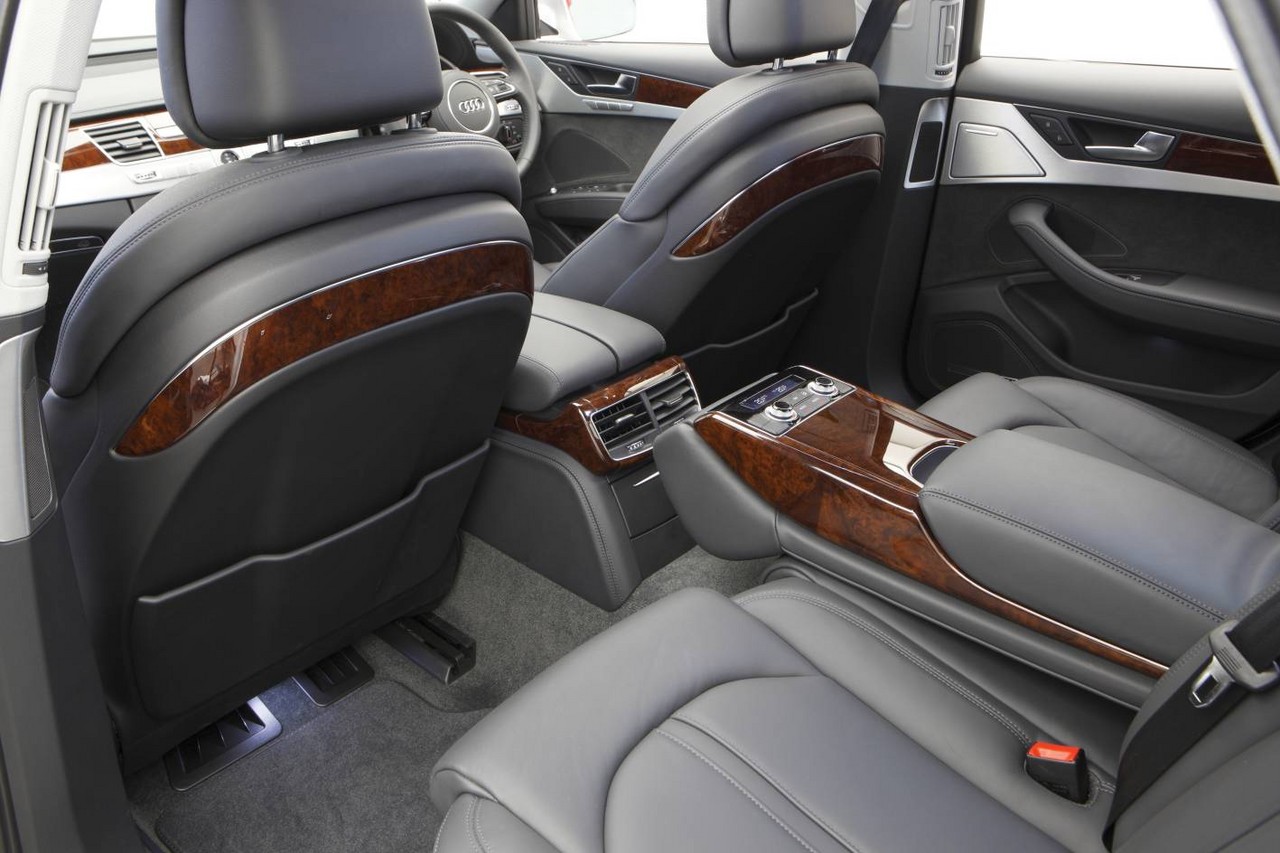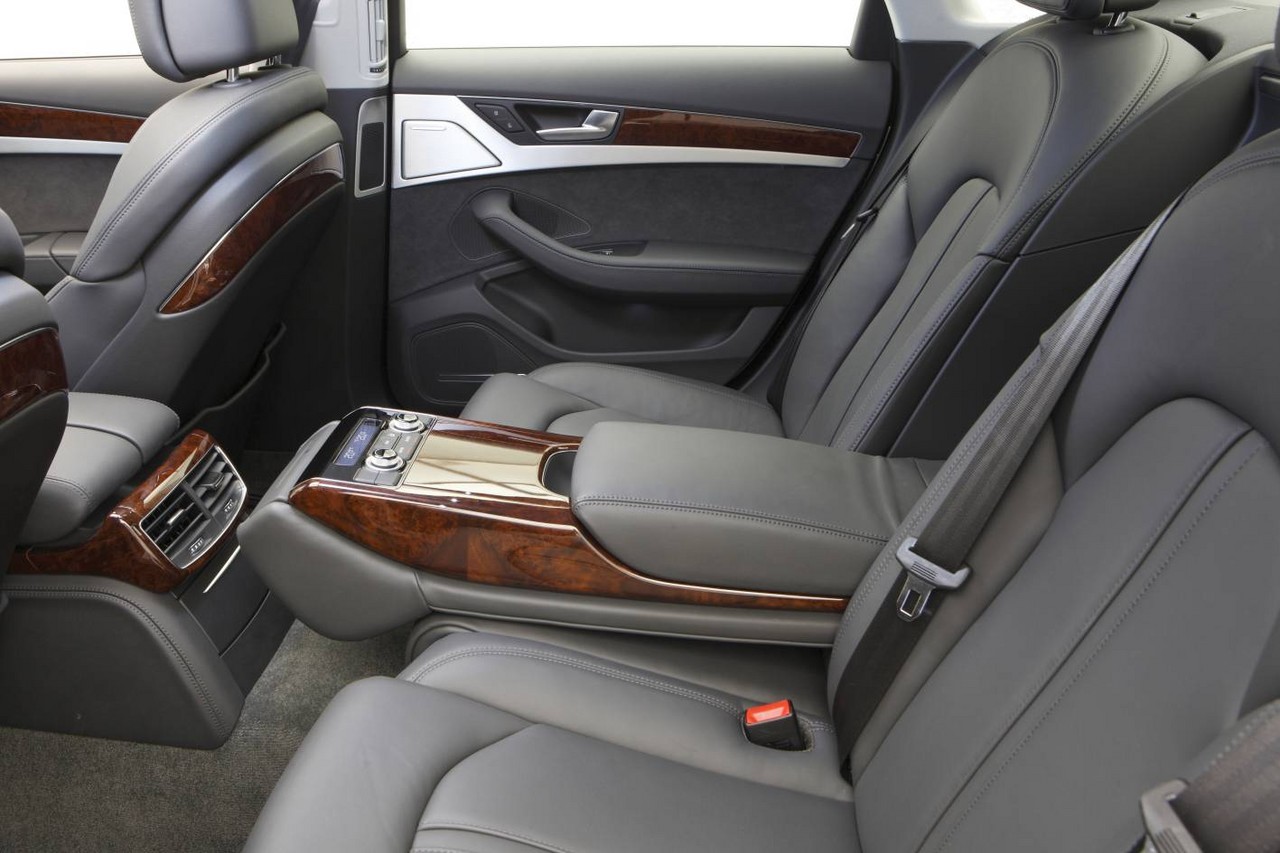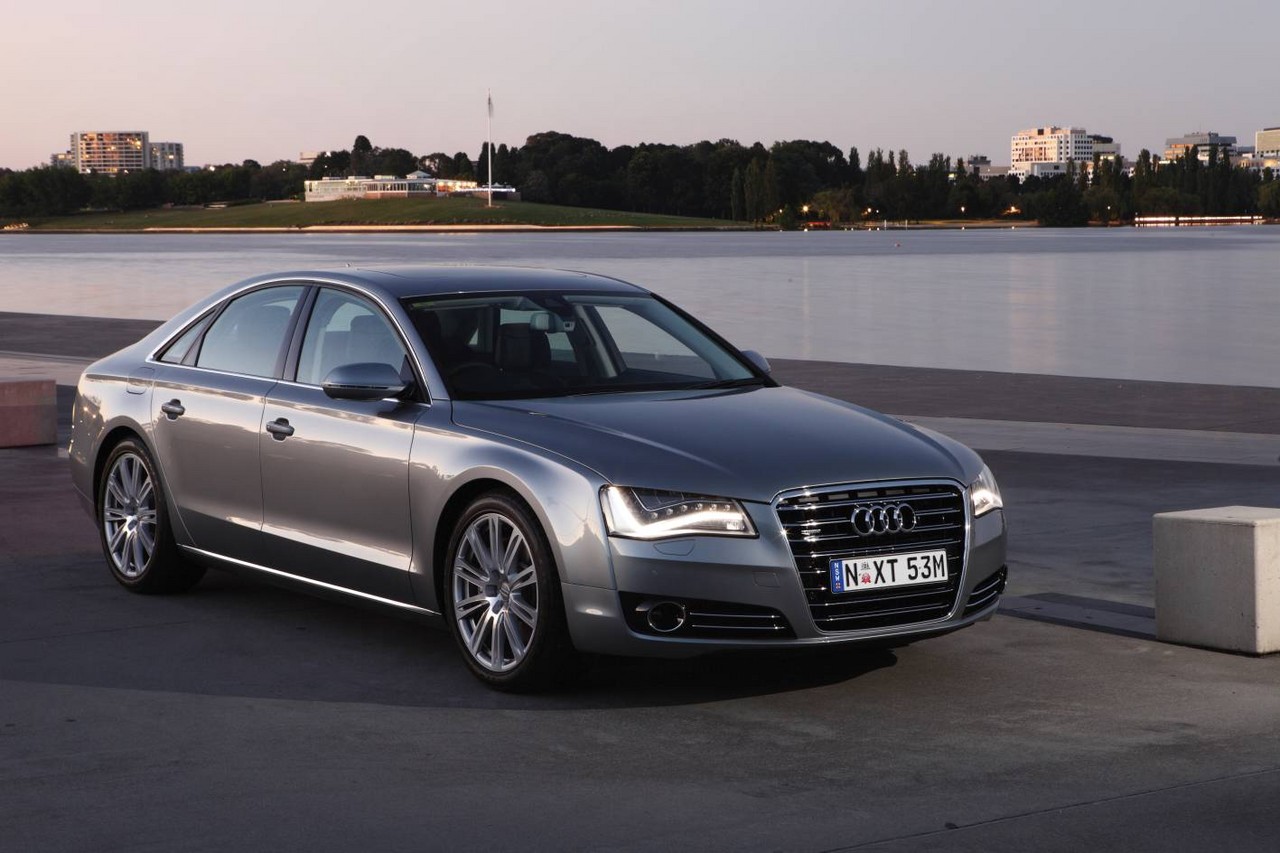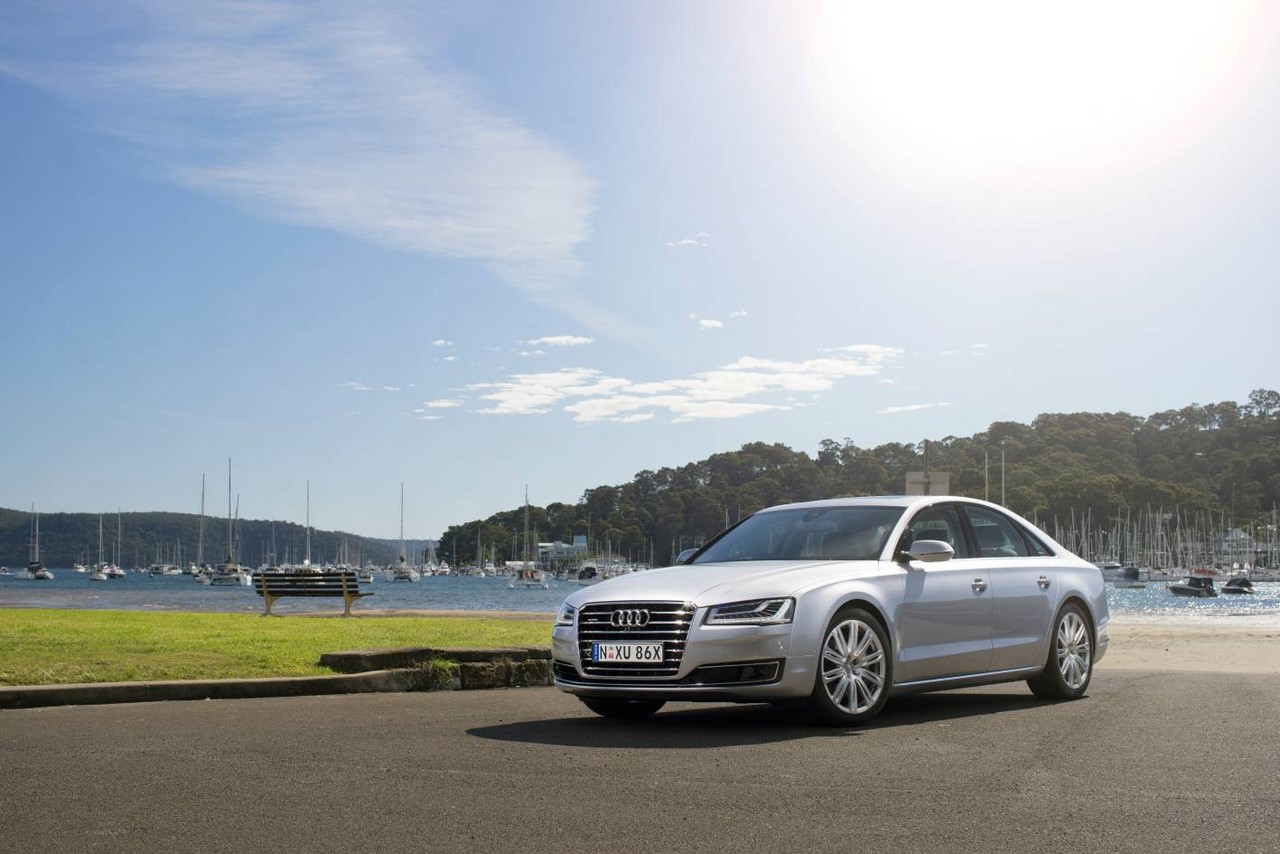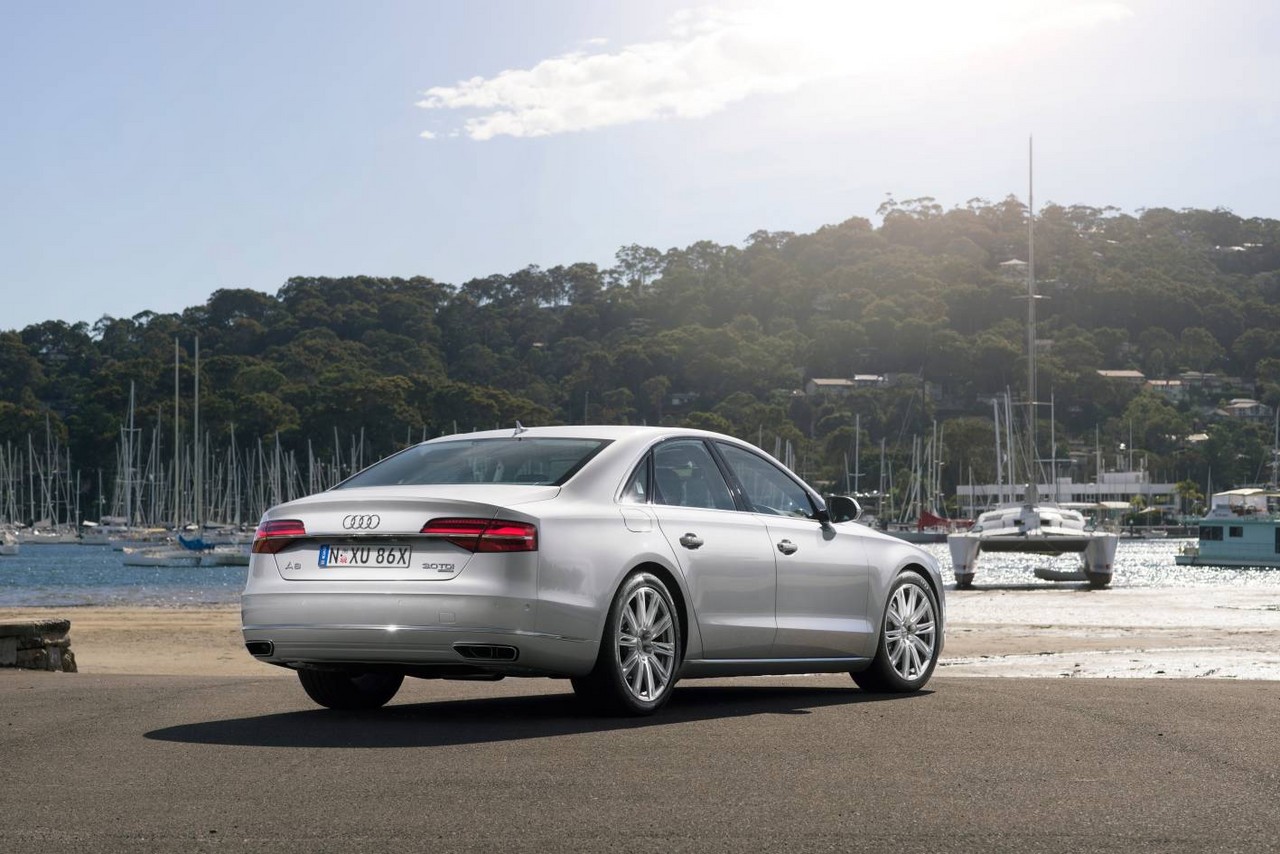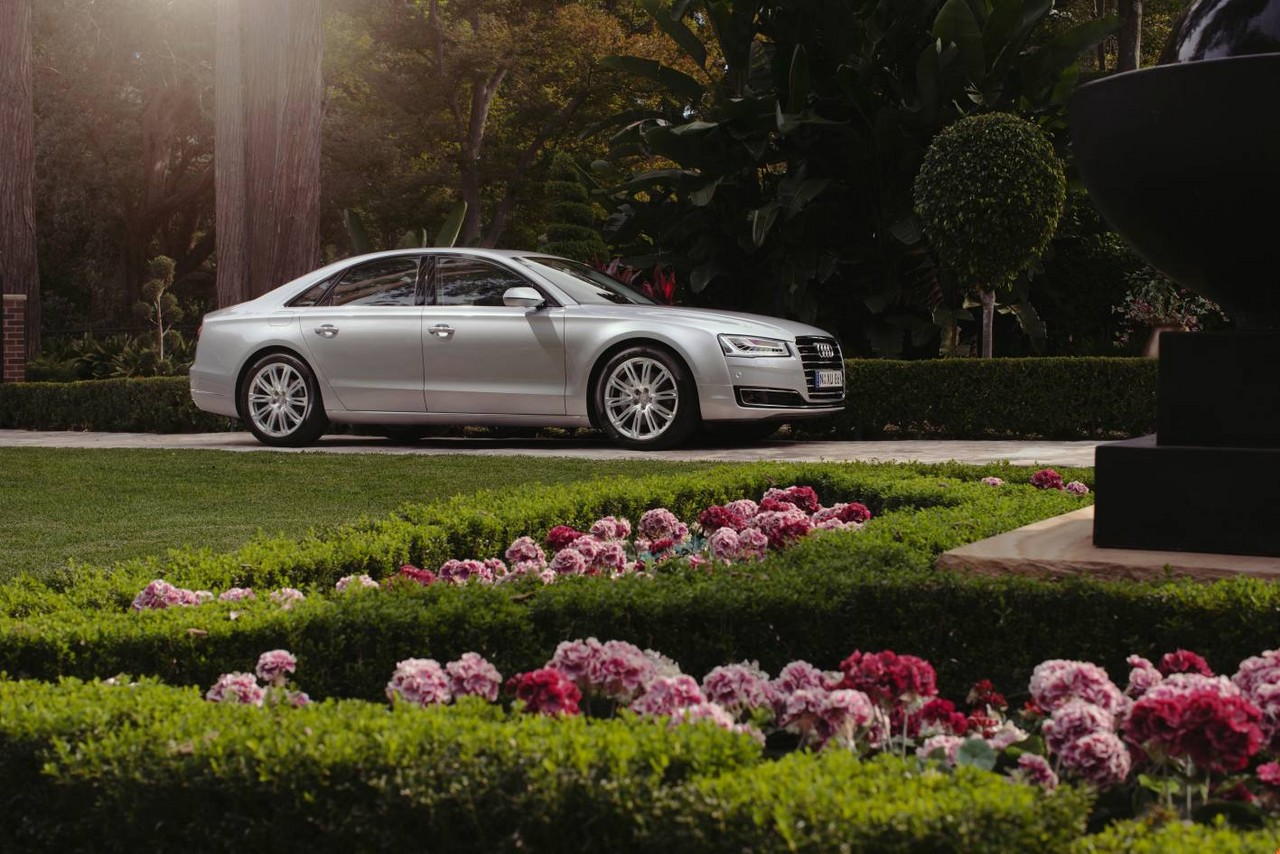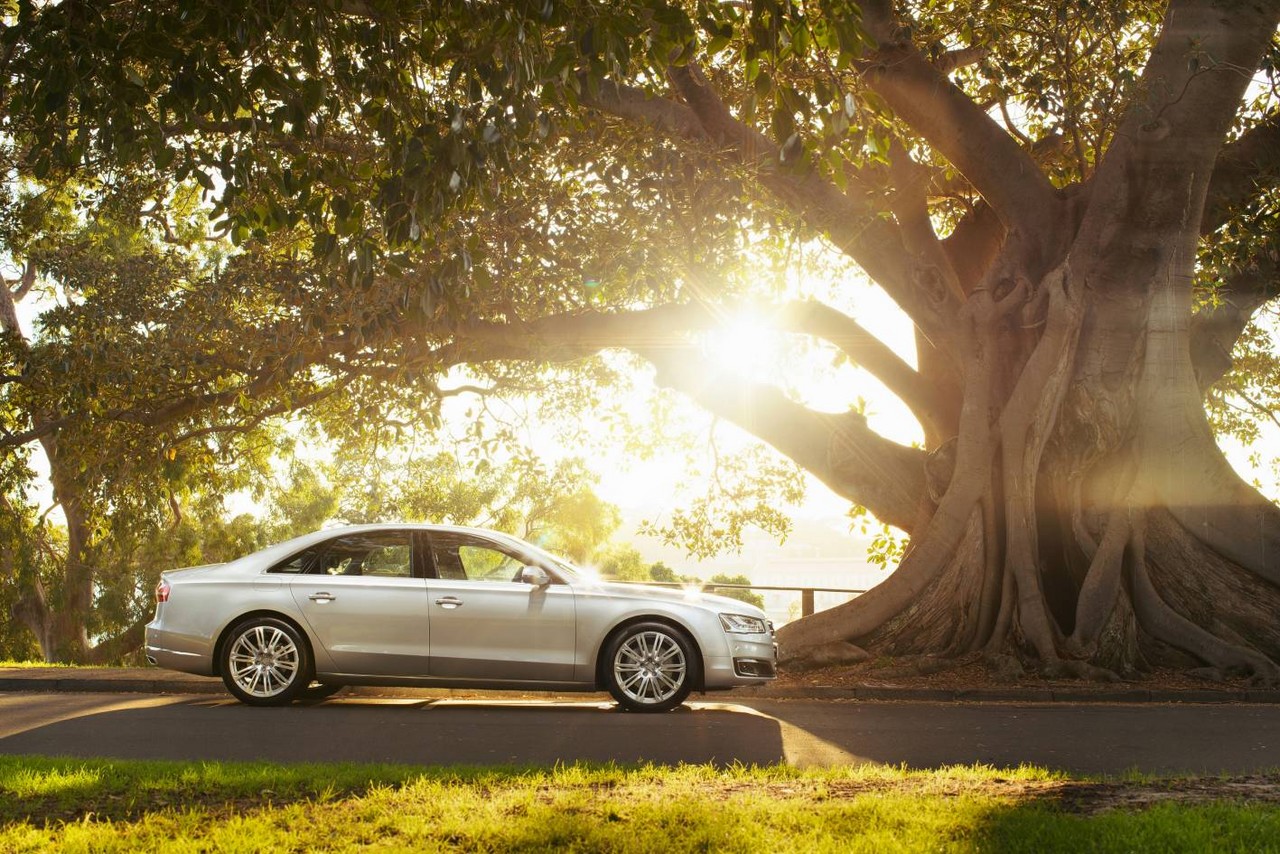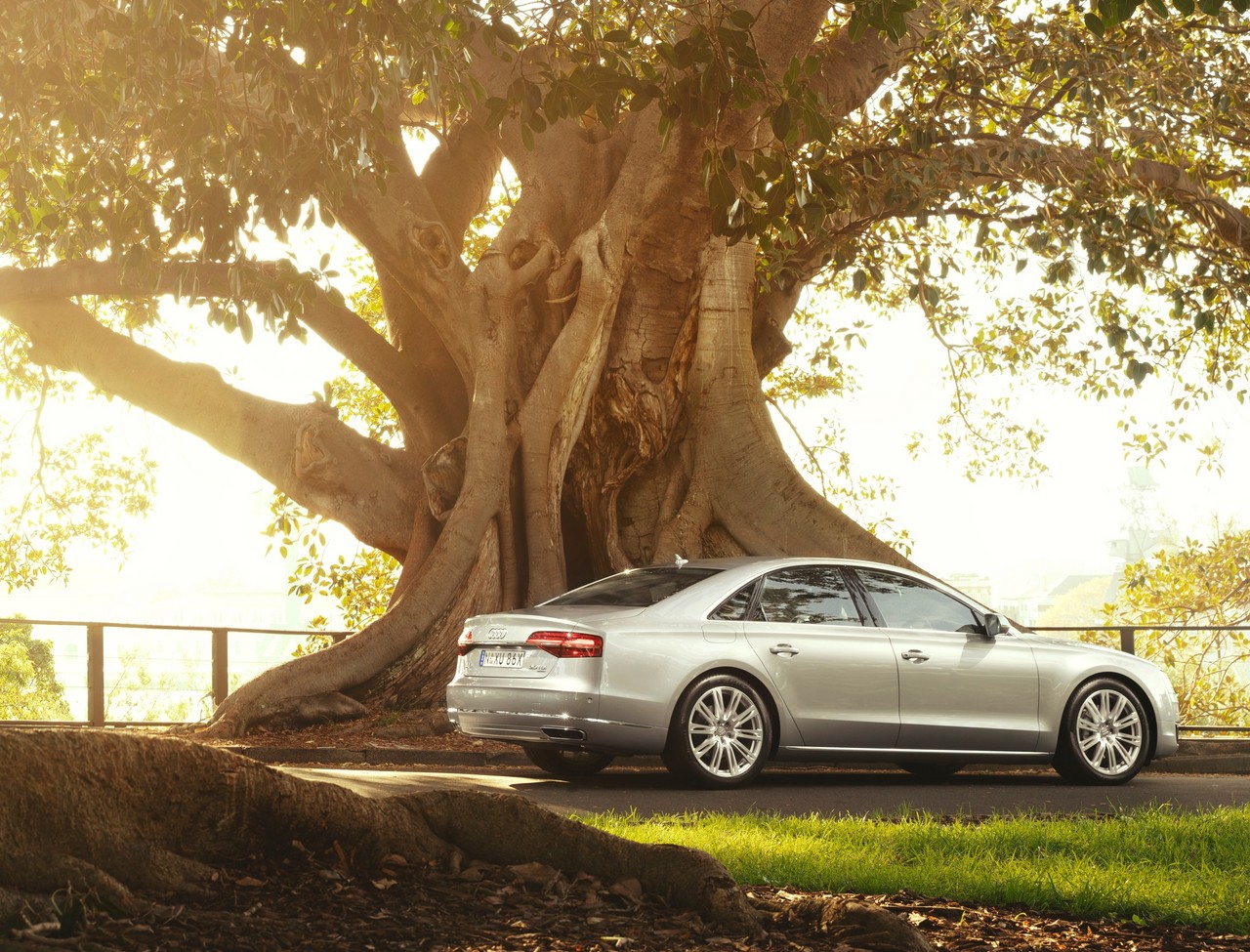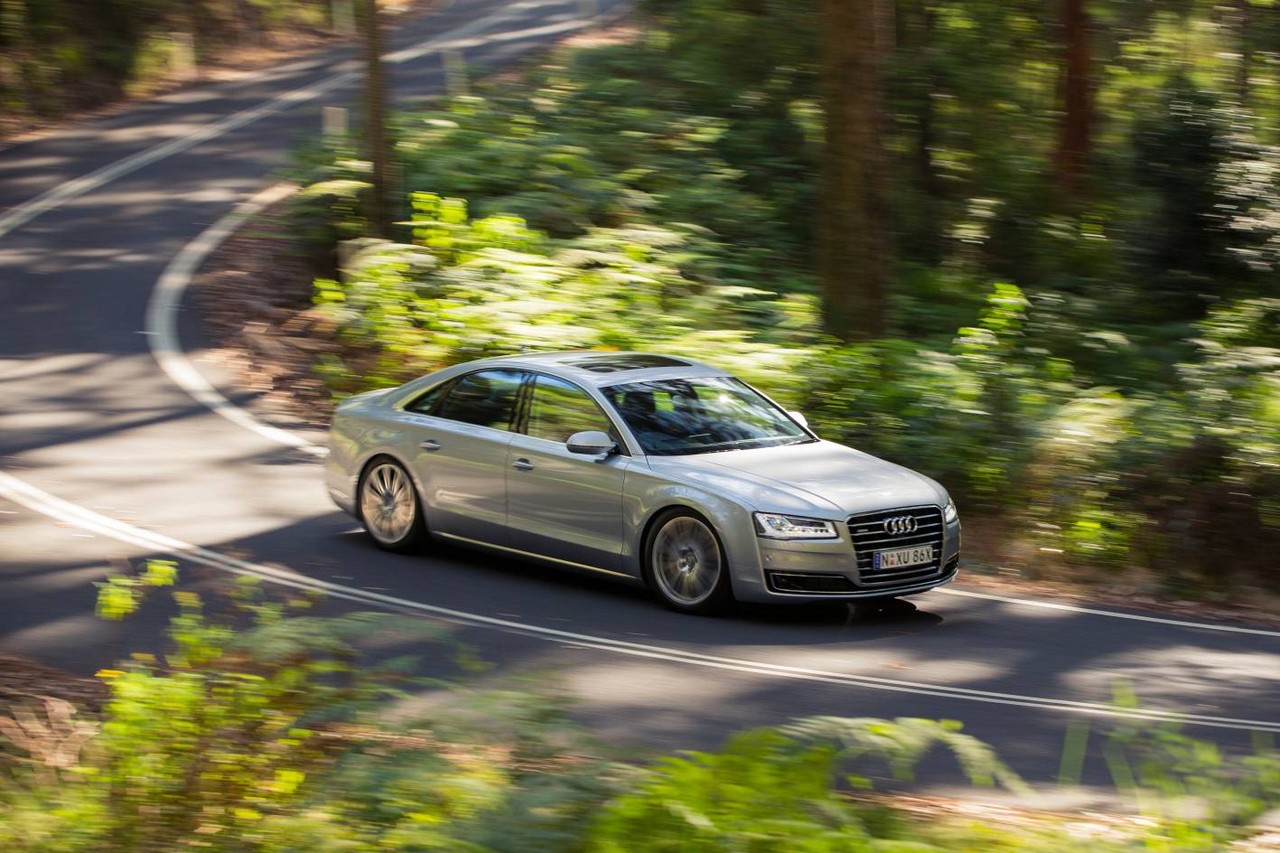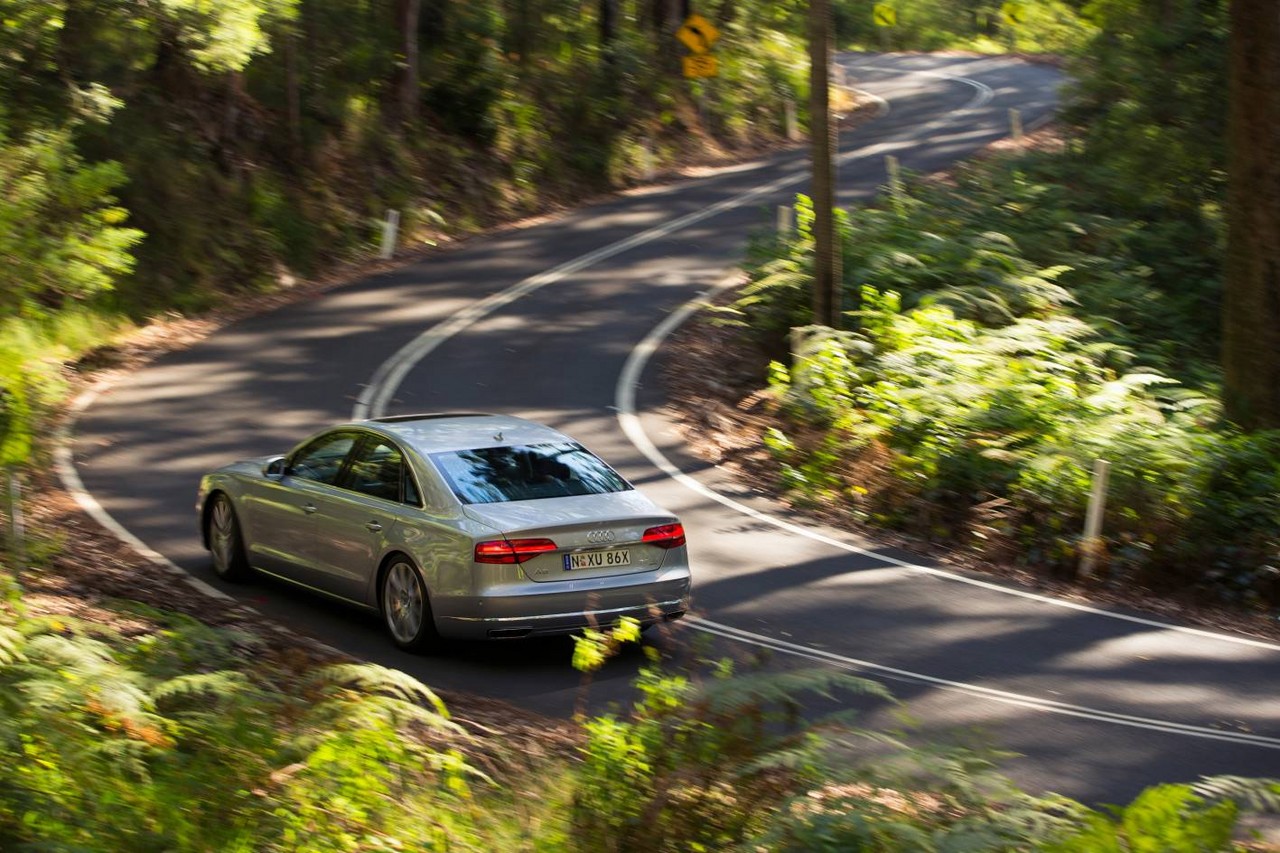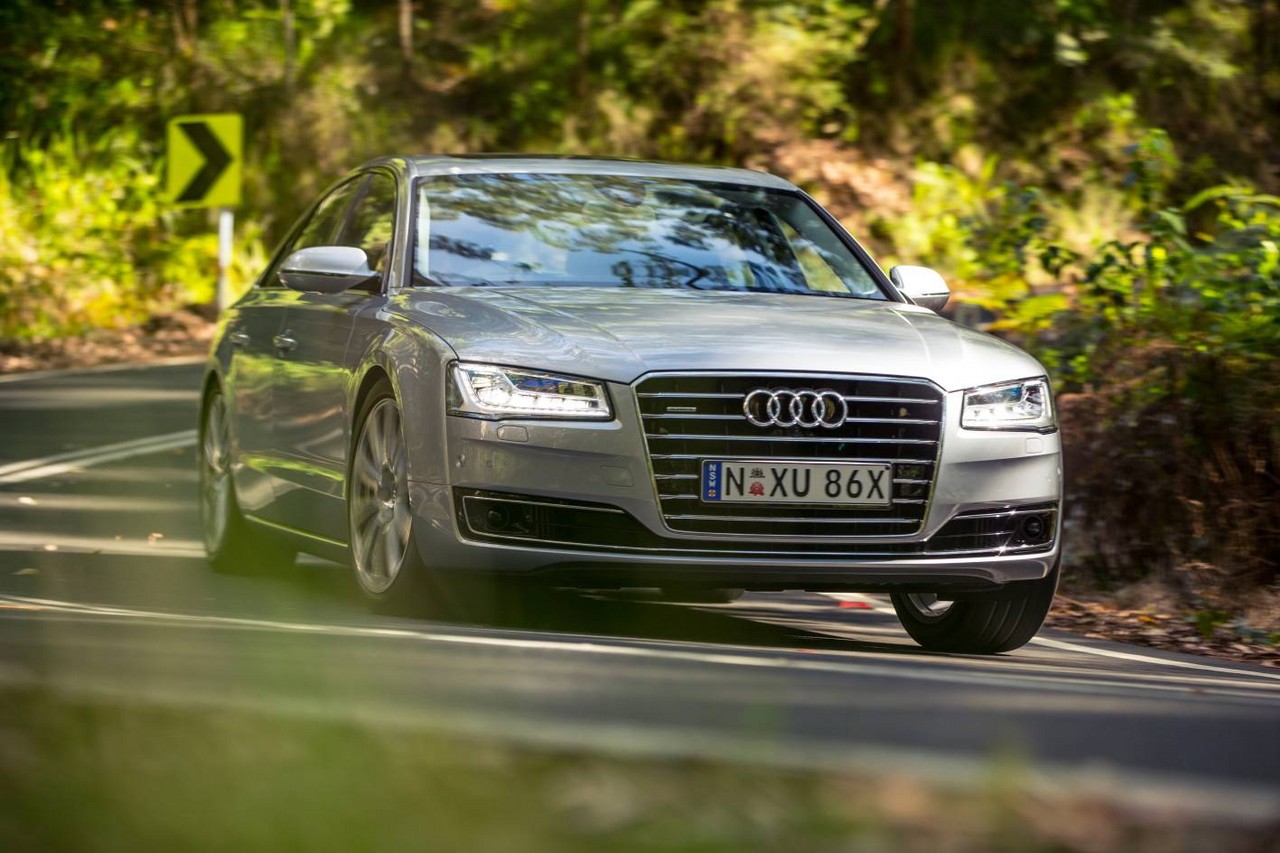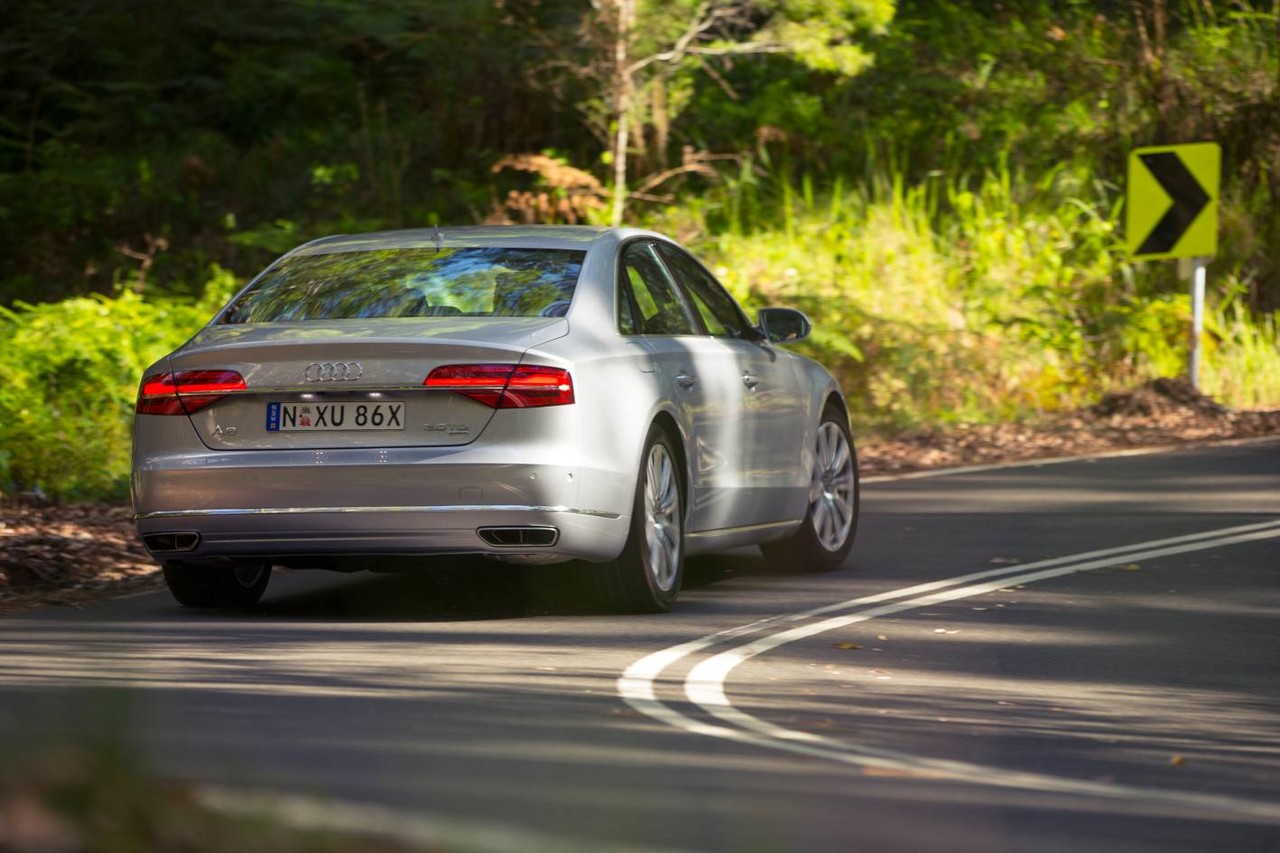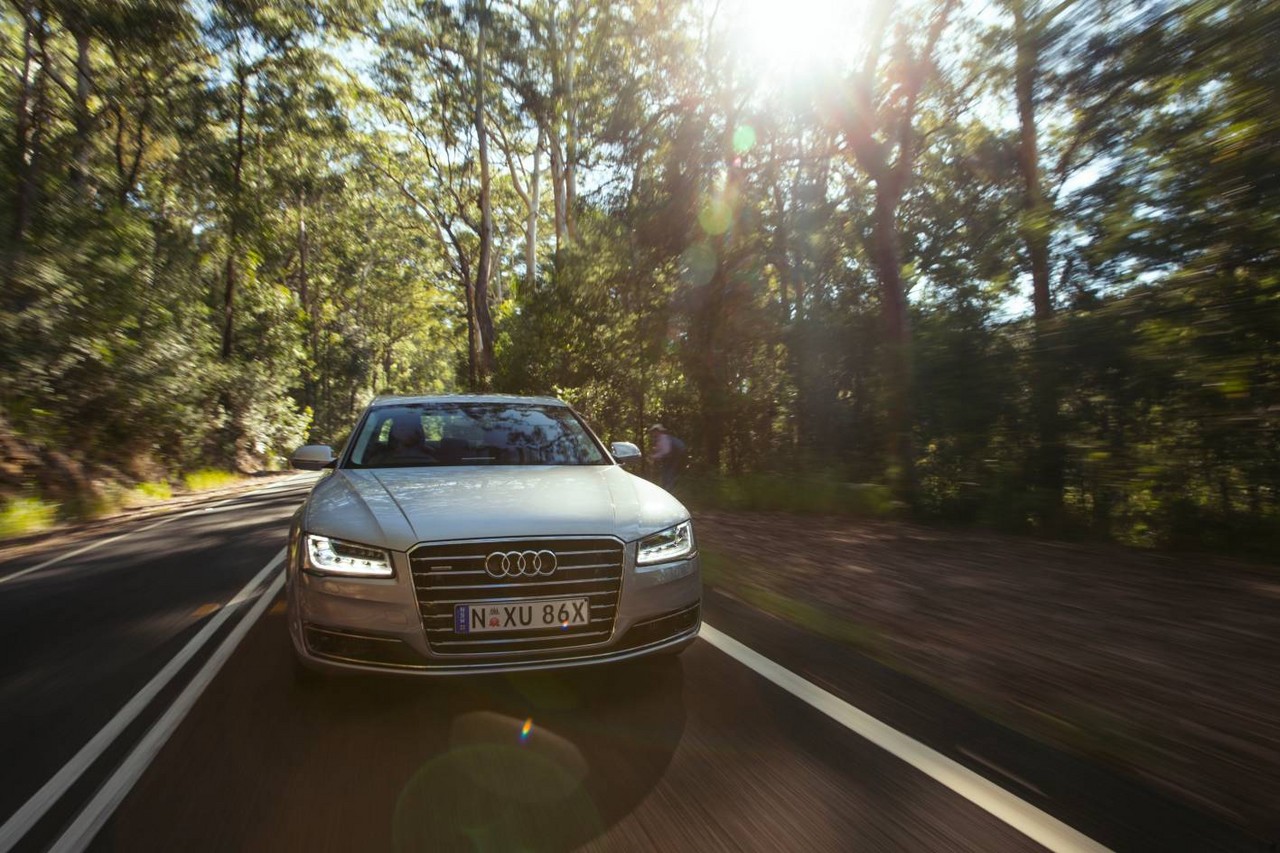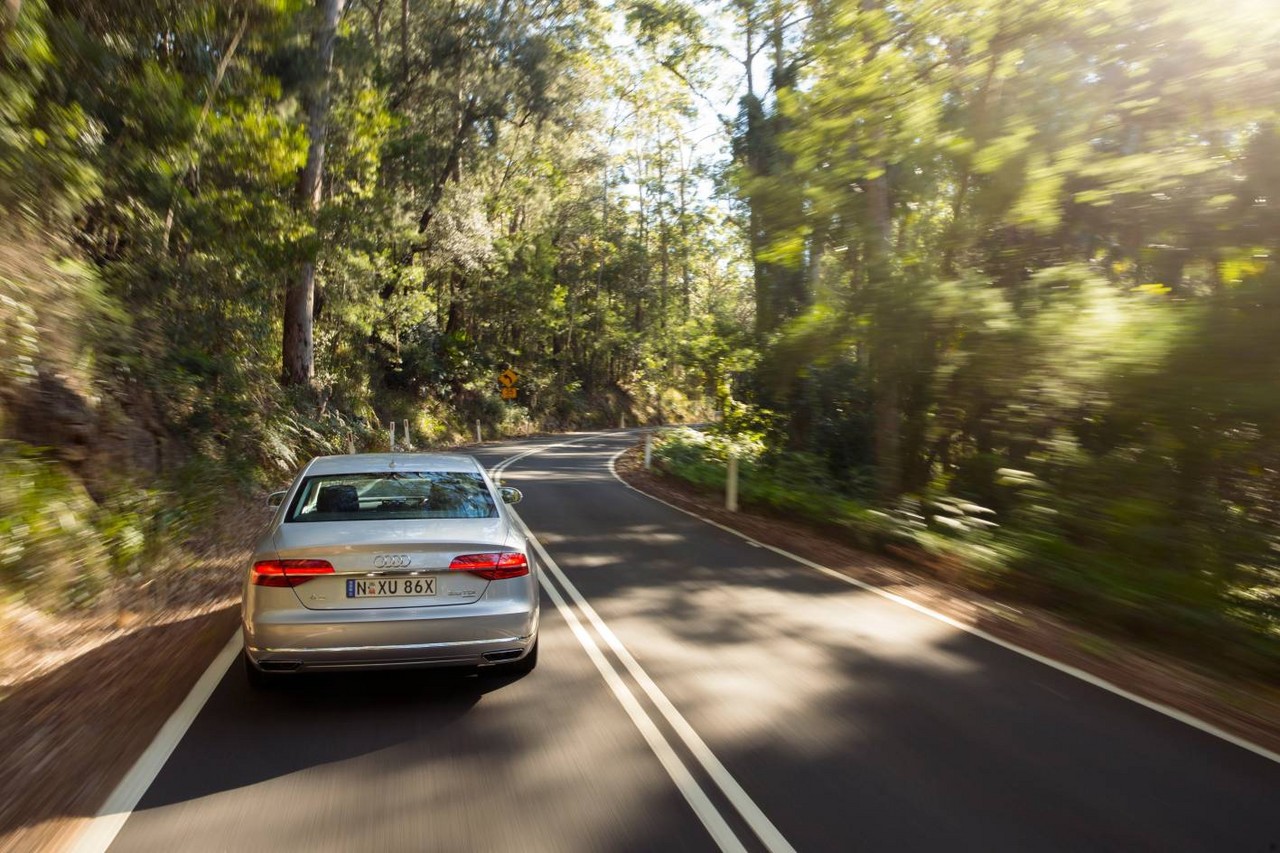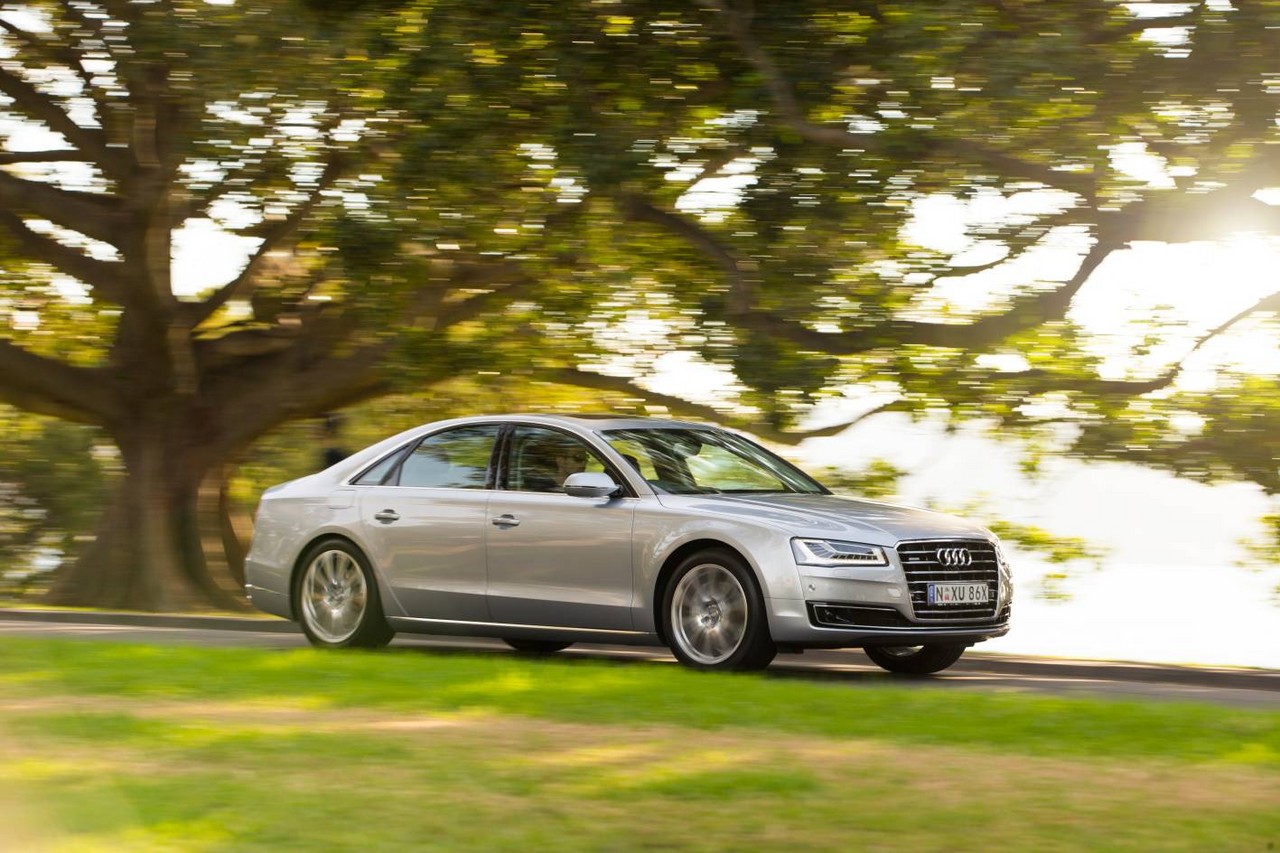
- High standard of interior fit and finish
- Frugal turbo-diesel engines bring grunt
- quattro system provides excellent traction
- Slight lack of body control through corners and over bumps
- Steering lacks feel
- Lacks presence and status of Mercedes-Benz W221/V221 S-Class
Review: Audi D4.I A8 (2010-13)
Overview
Released in July 2010, the Audi D4 Series I (D4.I) A8 was a large, four-wheel drive luxury sedan. Manufactured in Neckarsulm, Germany, the Audi D4.I A8 range consisted of three variants – 3.0 TDI, 4.2 FSI and 4.2 TDI – which were available in standard and long wheelbase models (SWB and LWB, respectively). Unique within the range, the 3.0 TDI variants were fitted with an idle stop function which enabled the engine to shut down when the vehicle was stationary in traffic.
| Variant | W/base | Years | Engine | Trans. | Peak power | Peak torque |
|---|---|---|---|---|---|---|
| 3.0 TDI | SWB | 2010-13 | 3.0-litre CDT turbo-diesel V6 | 8sp auto | 184 kW at 4000-4500 rpm | 550 Nm at 1500-3000 rpm |
| LWB | 2011-13 | |||||
| 4.2 FSI | SWB | 2010-13 | 4.2-litre CDRA petrol V8 | 8sp auto | 273 kW at 6800 rpm | 445 Nm at 3500 rpm |
| LWB | 2011-13 | |||||
| 4.2 TDI | SWB | 2011-13 | 4.1-litre CDSB twin-turbo diesel V8 | 8sp auto | 258 kW at 4000 rpm | 800 Nm at 1750-2750 rpm |
| LWB | 2011-13 |
Dimensions
Compared to the Audi D3 A8 , the D4 A8 was 86 mm longer (at 5147 mm), 55 mm wider (1949 mm), 23 mm taller (1467 mm) and had a 48 mm longer wheelbase (2992 mm). For the long wheelbase models, the wheelbase – and hence length – was increased by 130 mm. Like its D3 predecessor, the D4 A8 had an aluminium monocoque whereby the aluminium body panels also had a load-bearing function (the Audi Space Frame). For the D4 A8, however, static torsional stiffness increased by 25 per cent due to the use of higher-strength body components.
Suspension
The Audi D4 A8 had five link front suspension with two transverse links on the upper plane, the support link and control arm in the lower plane and a track rod. Furthermore, the rear suspension had track-controlled, hollow-cast trapezoidal links with the struts resting directly on the wheel carriers. The A8 was also fitted with adaptive air suspension with controlled damping; the driver was also able to select from ‘comfort’, ‘auto’, and ‘dynamic’ modes.
quattro
The Audi D4 A8’s ‘quattro’ four-wheel drive system included a ‘Crown Gear’ centre differential. In normal conditions, the system provided a 40:60 front:rear torque split. If traction was lost, however, up to 85 per cent of the engine’s torque could be directed to the rear axle, and up to 70 per cent to the front axle. The system also included open front and rear differentials with electronic differential locks which could brake spinning wheels to enable cross-axle torque transfers.
The Audi A8 4.2 FSI and 4.2 TDI were also fitted with a ‘torque vectoring’ rear axle, which selectively distributed torque to the rear wheels to generate yaw and thereby correct over- or under-steer.
Safety equipment
Standard safety equipment for the Audi D4.I A8 included dual front airbags, side airbags for front and rear occupants, full-length curtain airbags (i.e. for front and rear occupants), ABS, electronic brake force distribution, brake assist, electronic stability control, traction control, active front seat head restraints and front seatbelts with pretensioners and load limiters. The A8 was also equipped with ‘pre-sense’ which prepared the vehicle for imminent collisions.
Features: A8 3.0 TDI
Standard features for the Audi A8 3.0 TDI included 18-inch seven-arm alloy wheels, Multi Media Interface (Audi’s ‘MMI’) with a 180 watt sound system with 10 speakers, a CD player and auxiliary inputs (iPod/USB/MP3), satellite navigation system, reversing camera and Bluetooth connectivity, four-zone climate control air conditioning, Valcona leather upholstery, 22-way power adjustable front seats, memory function for driver and passenger settings, cruise control, rear camera, bi-xenon headlights with LED daytime running lights, front and rear parking sensors, DVD player, proximity key, power adjustable steering column (height and reach), power windows and folding mirrors, power sunroof, voice recognition, electrochromatic rear view mirror, tyre pressure monitoring, an alarm and immobiliser.
Features: A8 4.2 TDI and 4.2 FSI
The A8 4.2 TDI and 4.2 FSI were further equipped with 19-inch ten-spoke alloy wheels, 14 speaker 600 watt Bose stereo, TV tuner, adaptive headlights with variable range control, ambient lighting, a power-operated boot lid and servo closing doors.
From September 2011, the A8 4.2 FSI and 4.2 TDI A8 variants were fitted with a digital radio receiver (DAB+) as standard.
Related links
Review: Audi D4.II A8 (2014-17)
Overview
Released in Australia in May 2014, the Audi D4 Series II (D4.II) A8 introduced more efficient engines and revised styling. Visually, the Audi D4.II A8 could be identified by its more sculpted front mask (including the bonnet, grille and front bumper) and straight lower edges for the LED headlights. At the rear, the D4.II A8 had flatter LED tail-lights and the redesigned bumper housed two rhomboid-shaped tailpipes.
Inside, the Audi D4.II A8 provided greater refinement through additional noise damping measures.
| Variant | W/base | Engine | Trans. | Peak power | Peak torque |
|---|---|---|---|---|---|
| 3.0 TDI | SWB, LWB |
3.0-litre CTB turbo-diesel V6 | 8sp auto | 190 kW at 4000-4250 rpm | 580 Nm at 1750-2500 rpm |
| 4.2 TDI | SWB | 4.2-litre CTE twin-turbo diesel V8 | 8sp auto | 283 kW at 3750 rpm | 850 Nm at 2000-2750 rpm |
Safety equipment
Compared to its D4.I predecessor, standard safety equipment for the D4.II A8 was extended to include adaptive cruise control and Audi’s ‘pre sense plus’ system. The pre sense plus system used two long range radars and a windscreen-mounted to camera to detect obstacles ahead. If the onboard computer determined that a collision was likely, visual and acoustic warnings would be given and the brake system would be pre-filled. If the driver failed to react, a braking jolt would occur as a ‘haptic’ warning, the braking system prepared so that if the driver did apply the brakes, then the appropriate braking force would be applied. If there was still no reaction from the driver, the system would apply partial braking to mitigate the collision and, if a collision could not be avoided, maximum braking force would be autonomously applied to reduce the severity of the collision.
Standard safety equipment for the A8 was also extended to include Audi’s active lane assist and side assist systems. Of these,
- the active lane assist system could make slight steering adjustments when necessary to keep the vehicle in its lane; and,
- the side assist system provided blind spot monitoring system via a rear-facing radar.
Features
Compared to its D4.I predecessor, standard features for the D4.II A8 3.0 TDI were extended to include 19-inch alloy wheels, a 600 watt Bose sound surround system with fourteen speakers and a twelve-channel amplifier, digital radio reception, Audi’s ‘MMI navigation plus’ system with an eight-inch retractable monitor, live traffic updates and MMI touch pad, an in-car Wi-Fi hotspot (‘Audi Connect’), heated and ventilated front seats, LED headlights, ambient lighting, a power-operated boot lid, power-assisted door closure and Audi’s ‘Park assist’ function which used twelve ultrasonic sensors to provide a 360 degree display of the vehicle and could autonomously steer the vehicle into parallel and perpendicular parking spaces.
Compared to the A8 3.0 TDI, the A8 L 3.0 TDI was further equipped with heated outer rear seats, power-operated rear sunblinds and rear vanity mirrors.
Relative to the 3.0 TDI, the 4.2 TDI was distinguished by its 20-inch alloy wheels, digital TV reception, front seat massage function, head-up display and ‘Matrix LED’ headlights which featured intelligent cornering lighting, dynamic turn signals and used predictive route data from the navigation system to adjust the distribution of light accordingly. The A8 4.2 TDI was also fitted with a quattro sport rear differential which could distribute power between the rear wheels to generate yaw and thereby reduce under- or over-steer.
Related links
- Press Kit: Audi D4.II A8 and S8 (May 2014)
- Specifications: Audi D4.II A8 (May 2014)
- Audi Australia: Audi A8
- Wikipedia.org: Audi D4 A8
